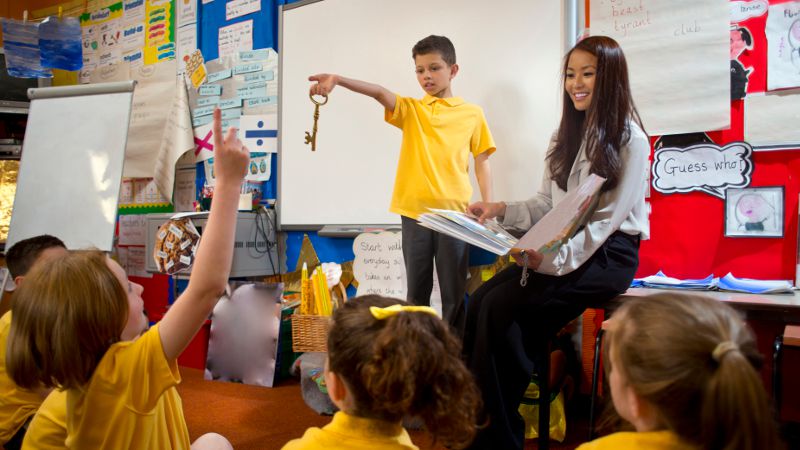
Metacognitive Skills: A Guide for Classroom Teachers, Teacher Aides and Students
Teach Kids How to Learn, How to Think, and How to Conquer Any Task
Metacognitive skills – often referred to as ‘thinking about thinking’, particularly to improve learning. Metacognitive skills include planning, mental scripting, positive self-talk, self-questioning, self-monitoring and a range of other learning and study strategies.

The term metacognitive skills may seem scary at first; it sounds like something out of a psychology course or a neuro-linguistic self-help book. As scary as it sounds, metacognition is simply ‘thinking about thinking’. In a practical sense, it is a fancy term for teaching students how to learn when the teacher isn’t around to help them.i For this reason and for simplicity, we use the term metacognitive skills in this book to include any study skills or techniques as well as any trick, tip or means by which learning and course-related tasks (such as exams and assignments) can be more effectively approached and executed.
Traditionally, a teacher’s main function was to teach knowledge, skills, ideas, concepts and problem solving. But what about occasions when there is no teacher? How do people learn in that case? Learning is an essential life-long skill. People who are effective self-directed learners are likely to be much more successful – they know how to learn, see the benefits of learning and enjoy the challenge of learning new things.
By empowering students with metacognitive skills, they become their own teacher and are capable of learning almost anything.
By empowering students with metacognitive skills, they become their own teacher and are capable of learning almost anything. Metacognitive skills are the ultimate in transferable skills – they can be used in any subject, career or workplace. Take a student who is stuck on a maths problem while their teacher is indisposed helping other students. What do they do? They could use a simple metacognitive skill such as chunking or ‘proceduralising’ the task. The student remembers the teacher talking about ‘process learning’ and decides to write out the individual steps required to solve this type of problem. By following and applying these steps, the maths question is now correctly solved. It is not a stretch to see how this strategy would be useful in almost any subject, course or workplace.
‘Metacognitive skills’ is a catch-all term for the dozens of techniques used to think and learn in a more efficient and effective way.ii By teaching these skills to students, they become self-directed life-long learners willing to take on bigger and bigger challenges. Common examples of metacognitive skills include planning to learn, reflection, self-assessment, think-alouds, developing and using processes, summarising and synthesising information, mental scripting and deliberate practice. Metacognitive skills also include some of the same strategies that teachers use, such as scaffolding and chunking. Individuals can apply these strategies to their own learning.
Hint: Metacognition can be thought of as a higher-order mental task where a person thinks about their learning, ways and options for approaching a learning task, what works and doesn’t work for them, what influences them and what motivates them. In one sense, metacognition is about ‘knowing thyself’ in terms of one’s ability to learn and it means the student can self-manipulate in order to achieve a positive learning outcome. Another term, ‘cognitive learning strategies’, is also worth mentioning. Cognitive learning strategies by comparison refers to a series of tools that are used on a daily basis to aid learning such as planning, organising, note-taking, comparing and summarising. As cognitive learning strategies are (in effect) a sub-set of metacognitive skills (metacognitive skills are needed to learn and select the best cognitive strategy as well as to consciously embed them in everyday learning), we simply use the single term metacognitive skills, as do many educationalists.
Metacognitive skills should be explicitly taught to students of all ages, including adolescents and adult learners.iii Explicit teaching of metacognitive skills is not a one-off activity or something that is done once or twice a year. Best-practice teaching is to incorporate metacognitive skills whenever possible – usually this means at least once a lesson or more.iv In fact, students should be sick and tired of hearing about metacognitive skills – if they are, this means that those skills are starting to sink in. Teachers should use the term metacognitive skills on a regular basis. It should become standard vocabulary in the classroom.
Constant reminders and the repeated use of terms such as metacognitive skills, think-alouds, chunking, process learning and scaffolding help to cement these strategies into the daily learning habits of students. Posters are available that can be displayed around the room or a simple list can be given to students at the start of the year to stick to the inside of their folder. Each week the class may concentrate on a new metacognitive skill which is written in large font at the top of the board. When using a think-aloud, spend 30 seconds asking and explaining to students why think-alouds are effective and how they can be used at home. Teach students about SMART goals and ask how they can be used to achieve non-school-based goals such as learning to ride a horse or saving money.v
It should be noted that students already possess and use a wide range of learning strategies such as ‘asking a friend’ and ‘trial and error’. However, most of these strategies are ineffective, by and large. On the other hand, making metacognitive skills a substantial part of the teaching program will yield surprising short-term and long-term results.vi There are 2 ways to teach metacognitive skills: explicitly and embedded. For maximum effect, both ways should be used. Explicitly teaching metacognitive skills lays the foundations, while embedded teaching consolidates and reinforces them. Explicit teaching of metacognitive skills involves openly talking to students about them. This can be done either via a standalone metacognitive activity of 5-10 minutes or they can be explicitly addressed as part of a learning activity of some kind. Metacognitive skills should be a cross-curriculum priority and at the very least, a secondary learning goal of any program.
There are 2 ways to teach metacognitive skills: explicitly and embedded. For maximum effect, both ways should be used.
Here is a simple example showing the effectiveness of metacognitive skills in a stressful exam or test:
- A student’s first reaction to the test is ‘I am confused and overwhelmed – this is too hard’.
- The student uses think-aloud/self-talk: ‘Okay what strategies might work here, let’s list a few’.
- The student decides to use a ‘divide and conquer’ (chunking) approach.
- The student divides the exam into sections from easiest to hardest.
- The student completes the easy parts first in order to isolate the more difficult parts.
- The difficult parts are then divided into sections and tackled piece-by-piece.
- The student checks for basic errors and takes a best-guess, process-driven approach to the few questions that were unexpected.
Hint: metacognition skills are similar in nature to ‘executive functioning skills’. However, executive functioning skills are higher-order (somewhat innate) skills such as memory and inhibitory control (self-control). Executive functioning programs are mainly taught to students with neurological disorders.
Metacognition is the active and conscious process of considering the best options for any given task. What works in one situation may not be useful in the next. Because of this, the more metacognitive skills that students can learn the better. The first step is to emphasise that knowing about and using metacognitive skills is valuable and effective. The second step is to provide students with a range of metacognitive skills which they collect and add to their toolbox of options, such as:
- planning (chunking, divide and conquer, scaffolding from easiest to hardest, from unknown to mastery)
- reflective practice (reviewing performance, strengths and weaknesses)
- seeking help (from various sources and collecting and analysing information)
- setting goals (deadlines, SMART goals, micro-goals, long/short-term rewards)
- self-questioning and self-monitoring (‘am I going about this the right way?’)
- think-alouds, self-talk and mental scripting
- the use of a wide range of learning strategies such as graphic organisers, brainstorming, learning by teaching, writing to learn, re-reading, summarising and categorising
- list writing for organisation/memory and accountability (including re-writing as the task progresses)
- seeking and acting on feedback from others (particularly experts). Feedback should be viewed by students as a useful mechanism for improvement and not a personal attack.
- recognising and managing impediments to learning such as distractions, contradictory information, feelings of frustration and anger, excuses, procrastination and peer pressure)
- examining tasks before starting (what is un/known, steps/parts of the task, learning strategy, source of information, setting goals and timelines, identifying potential issues)
- ways of measuring performance (self-assessment against goals, comparisons and benchmarks)
- study skills such as spaced practice and deliberate practice (for exams, homework, personal learning and career).
- specific learning skills for certain activities such as re-reading, active reading, using cues, prediction, re-telling, summarising and critical literacy skills to help with reading comprehension
- practise assessing personal abilities (accurately and honestly) while remembering that ‘you don’t know that you don’t know’. Be aware of the Dunning-Kruger effect – people who know the least tend to over-estimate their abilities the most. This is because unskilled people have a narrow and simplistic understanding of the topic. Conversely, people who know the most, tend to underestimate their abilities as they are aware of how much is unknown (by them or by anyone).vii
- having a growth mindset (believing that learning is possible irrespective of intelligence or past performance) as opposed to a fixed mindset (believing that intelligence is set for life and cannot be altered – for example, ‘I’m dumb at maths and that will never change’).
The best thing about metacognitive skills is that they are universal. They can be used in almost any subject, course or whenever there is a need to learn something new. This is important because much of what students learn in a given subject is only relevant to that specific subject. This is not the case with metacognitive skills however – once students learn a metacognitive skill, they can apply it in any subject. From a time perspective, teaching metacognitive skills is very efficient because it can lead to improvements in multiple subjects. Put another way, teachers and students ‘get more bang for their buck’ as far as time and effort spent learning metacognitive skills.
The best thing about metacognitive skills is that they are universal. They can be used in almost any subject, course or whenever there is a need to learn something new.
Planning an approach to learning is one of the more important metacognition skills; it is the ultimate technique for self-directed learning. Unfortunately, planning is not something that comes naturally to everyone. Before beginning any learning task, time should be spent planning the best approach. New teachers often rush to get students started on a task as quickly as possible, so it looks like their students are working. However, a few extra minutes thinking about and discussing possible ways to approach the task yields more positive results. For example, before starting a maths worksheet with 10 problems, students should be reminded about what to do if they are stuck (skip it, break down into parts, use their best guess, think of the process etc.). Without this advice, many students get stuck on a question, become flustered and simply give up, claiming ‘maths is not my thing’.
Foot notes:
- Also note terms such as ‘meta-learning’ which may be more accurate. However I have not used it as it seems to be widely accepted as referring to machine learning in the AI space.
- Wilson, N. S., & Bai, H. (2010). The relationships and impact of teachers' metacognitive knowledge and pedagogical understandings of metacognition. Metacognition and Learning, 5(3), 269-288. doi:10.1007/s11409-010-9062-4.
- Maitland, L. E. (2000). Ideas in practice: Self-regulation and metacognition in the reading lab. Journal of Developmental Education, 24(2), 26-36.
- Schraw, G. (1998). Promoting general metacognitive awareness. Instructional Science, 26, 113-125. doi:10.1023/A:1003044231033.
- SMART goals are used in many industries including project management, sports science and business.
- Zhang, L. J., & Wu, A. (2009). Chinese senior high school EFL students’ metacognitive awareness and use of reading strategies. Reading in a Foreign Language, 21, 37–59.
- A related aspect of this effect is that students become better at self-assessment as they practise self-assessment and as they get better at a task. This has implications for teachers because students’ initial assessment of their skills may be incorrect, but it may be more reliable as they near the point of mastery.






















